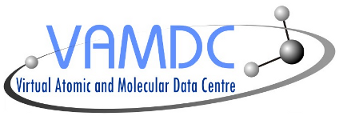

In VAMDC, different pieces of software need to communicate to each other. Apart from protocols and schema, a common vocabulary is needed. By this we mean a list of “global keywords” that should consist of reasonably short, human-readable keywords which uniquely define a certain type of information or data. In the following we describe how the keywords were created and how they are used in different parts of VAMDC software. The common gain in the various aspects is that the vocabulary allows to split the tasks that are common to all data sets from the database-specific information and routines. Thereby it becomes possible to implement software that can be re-used by multiple datasets, reducing the deployment on a new data set to implementing the parts that are truly specific for it.
In order to compile a list of well-defined names for all kinds of information that VAMDC datasets can contain, we started from the XSAMS schema for atomic and molecular data, that is used as a main data model within the project.
Flattened and stripped, xsams-derived keywords took form like AtomStateLandeFactor, SourceAuthorName, MolecularSpeciesIonCharge.
The keywords representing desired branches of XSAMS like Species,Processes, RadiativeTransitions,Collisions were added, those would find use in future VSS2 query language.
The VAMDC keywords form three overlapping subsets:
- Restrictables, used in registries and in VSS query language, any client software and VAMDC user portal must use them to be able to request the data from VAMDC.
- Returnables that are currently used in registries and internally in the Django TAP-VAMDC service implementation, they define placeholders in XSAMS tree for user data output.
- Requestables that are due to be added to the VSS2 version of the query language. They would describe the branches of the XSAMS schema client wants to see in the output document produced by the service.
The two aforementioned dictionaries RETURNABLES and RESTRICTABLES contain the most important information about each data set in the form of global keywords: what kind of data is contained in the database and which of these make sense to restrict in the query. By using only the keys in these key-value pairs we can compile this information in a format (XML-template) that the registry understands. Once this extension to the registry is specified, the portal will be able to decide from the information in the registry which databases might have a sensible answer to a particular query and only send it to these.
In data model VAMDC does not enforce the use of a certain unit for a certain physical quantity. However, in order to make queries understood by all nodes, the keywords that are used as RESTRICTABLE have a default unit, which is the one used in the query. This means that each node must be aware and convert the query to its internal unit before executing the query. For returned data the node is free to use whatever applicable units from XSAMS UnitsType.